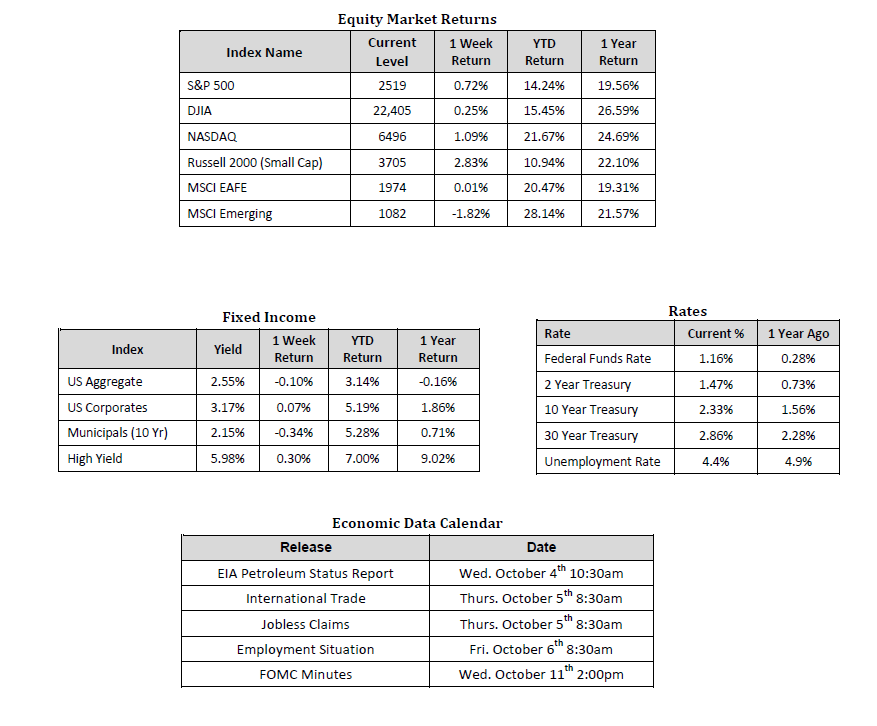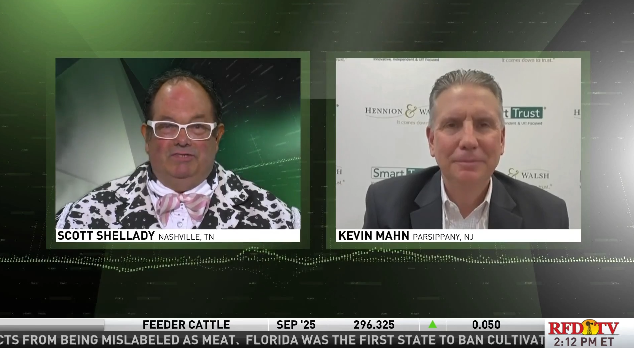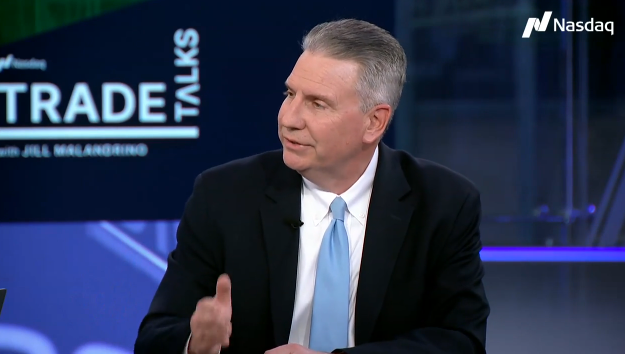
Potential Implications of Tax Reform on the Stock Market
Market Overview

Sources: Sources for data in tables: Equity Market and Fixed Income returns are from JP Morgan as of 9/29/17. Rates and Economic Calendar Data from Bloomberg as of 10/02/17. International developed markets measured by the MSCI EAFE Index, emerging markets measured by the MSCI EM Index. Sector performance is measured using GICS methodology. S&P 500 earnings data from Factset as of 9/29/17.
Happening Now
Domestic stocks rose during the final week of the third quarter while developed international markets stayed flat and emerging international markets sold off. The S&P 500 index gained 0.7%, outpaced by both midcaps, which advanced 1.1%, and small caps, which increased 2.8%. Overseas, developed markets finished the week with a 0.01% tick higher while emerging markets fell 1.8%. For the quarter, international stocks reigned supreme with developed markets gaining 5.5%, and emerging markets moving 8% higher. These results outpaced the still impressive 4.5% quarterly gain of U.S. stocks.
Last week, risk assets got a jolt from renewed discussions of tax reform in the U.S. The administration provided an initial 9-page outline for their plan but left out many key details that are needed to conduct a full analysis of the impact of the plan on individuals. What was made clear was the intent to lower corporate taxes and bring home overseas cash. Under the proposal, corporate rates would be lowered from 35% to 20% and a one-time repatriation of overseas cash would be allowed at a discounted tax rate. Should this type of legislation be passed, we believe it would provide a lift for U.S. stocks overall but small caps, the financial sector and the technology sector may stand to benefit the most.
Small cap companies, on average, pay 32% in corporate taxes. This figure is noticeably higher than the 26% average rate paid by companies in the S&P 500 index. The financial sector, in addition to benefiting from higher interest rates and the potential for future regulatory reform, pays a higher average tax rate than the S&P 500 overall. Tax reform could provide a boost to a sector that not only stands to benefit from the tailwinds outlined above, but also trades at an attractive valuation relative to the rest of the market. Finally, technology stocks, which generate nearly 60% of their sales from international sources, hold high amounts of cash overseas. In this regard, according to a Goldman Sachs Portfolio Strategy Research report entitled, “US Equity Views: Overseas cash repatriation would boost shareholder returns and growth investments”, of the top 20 stocks with the highest overseas cash positions as of September 22, 2017, 11 are associated with technology companies.
Last month, we saw a revival of the trading environment that followed Donald Trump’s election in November of 2016. Rates moved higher, cyclical sectors outperformed and value stocks beat growth stocks. Many individuals have expressed concerns about the valuation of the U.S. stock market and the length of the current bull market cycle. It is likely that these concerns have led investors to reduce risk by underweighting cyclical areas of the market or reducing their allocation to stocks altogether in favor of cash or fixed income investments. We believe there are more efficient ways to add diversification to a portfolio without having to try and time the market or rotate into and out of sectors.
Important Information and Disclaimers
Disclosures: Hennion & Walsh is the sponsor of SmartTrust® Unit Investment Trusts (UITs). For more information on SmartTrust® UITs, please visit www.smarttrustuit.com. The overview above is for informational purposes and is not an offer to sell or a solicitation of an offer to buy any SmartTrust® UITs. Investors should consider the Trust’s investment objective, risks, charges and expenses carefully before investing. The prospectus contains this and other information relevant to an investment in the Trust and investors should read the prospectus carefully before they invest.
Investing in foreign securities presents certain risks not associated with domestic investments, such as currency fluctuation, political and economic instability, and different accounting standards. This may result in greater share price volatility. These risks are heightened in emerging markets.
There are special risks associated with an investment in real estate, including credit risk, interest rate fluctuations and the impact of varied economic conditions. Distributions from REIT investments are taxed at the owner’s tax bracket.
The prices of small company and mid cap stocks are generally more volatile than large company stocks. They often involve higher risks because smaller companies may lack the management expertise, financial resources, product diversification and competitive strengths to endure adverse economic conditions.
Investing in commodities is not suitable for all investors. Exposure to the commodities markets may subject an investment to greater share price volatility than an investment in traditional equity or debt securities. Investments in commodities may be affected by changes in overall market movements, commodity index volatility, changes in interest rates or factors affecting a particular industry or commodity.
Products that invest in commodities may employ more complex strategies which may expose investors to additional risks.
Investing in fixed income securities involves certain risks such as market risk if sold prior to maturity and credit risk especially if investing in high yield bonds, which have lower ratings and are subject to greater volatility. All fixed income investments may be worth less than original cost upon redemption or maturity. Bond Prices fluctuate inversely to changes in interest rates. Therefore, a general rise in interest rates can result in the decline of the value of your investment.
Definitions
MSCI- EAFE: The Morgan Stanley Capital International Europe, Australasia and Far East Index, a free float-adjusted market capitalization index that is designed to measure developed-market equity performance, excluding the United States and Canada.
MSCI-Emerging Markets: The Morgan Stanley Capital International Emerging Market Index, is a free float-adjusted market capitalization index that is designed to measure the performance of global emerging markets of about 25 emerging economies.
Russell 3000: The Russell 3000 measures the performance of the 3000 largest US companies based on total market capitalization and represents about 98% of the investible US Equity market.
ML BOFA US Corp Mstr [Merill Lynch US Corporate Master]: The Merrill Lynch Corporate Master Market Index is a statistical composite tracking the performance of the entire US corporate bond market over time.
ML Muni Master [Merill Lynch US Corporate Master]: The Merrill Lynch Municipal Bond Master Index is a broad measure of the municipal fixed income market.
Investors cannot directly purchase any index.
LIBOR, London Interbank Offered Rate, is the rate of interest at which banks offer to lend money to one another in the wholesale money markets in London.
The Dow Jones Industrial Average is an unweighted index of 30 “blue-chip” industrial U.S. stocks.
The S&P Midcap 400 Index is a capitalization-weighted index measuring the performance of the mid-range sector of the U.S. stock market, and represents approximately 7% of the total market value of U.S. equities. Companies in the Index fall between S&P 500 Index and the S&P SmallCap 600 Index in size: between $1-4 billion.
DJ Equity REIT Index represents all publicly traded real estate investment trusts in the Dow Jones U.S. stock universe classified as Equity REITs according to the S&P Dow Jones Indices REIT Industry Classification Hierarchy. These companies are REITSs that primarily own and operate income-producing real estate.



